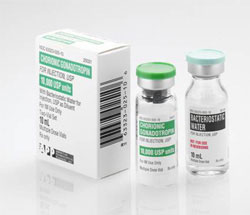You won’t see me promoting quick fixes or fad diets anytime soon. But every once in awhile something comes along that seems so dangerous I have to call it out. That’s why I’m going to help reveal the truth behind the HCG diet.

What it is: HCG (human chorionic gonadotropin) is a hormone produced during pregnancy by the cells that form the placenta. This hormone is detected in the blood around 11 days after conception; it is detected in the urine around 12-14 days after conception. While it is most commonly associated with pregnancy, it is present in both genders.
What it does in the body: HCG signals the hypothalamus (area of the brain that affects metabolism) to mobilize fat stores. In pregnancy, this helps the body bring nutrients into the placenta, fueling the fetus with the energy to grow.
The weight loss claim: The HCG diet (using daily hcg injections) will help you lose 1-3 pounds per day. The HCG-diet combines the daily injections with a very low-calorie diet (500 calories per day).
500-calories per day is severely restrictive! In fact, it is not enough calories to support normal brain function. Your body will compensate by using stores of glycogen, protein (muscle) and some fat, which lowers your resting metabolism. Before you can lose true weight, you will be so irritable, lightheaded, and cranky that you’ll reach for whatever food you can get your hands on and have a field day.
Scientific evidence: There is no scientific evidence supporting HCG injections as a weight loss strategy. In addition, these injections have not been approved by the FDA for use in weight loss. In fact, since 1975 the FDA has required all marketing and advertising of HCG to state the following: “HCG has not been demonstrated to be effective adjunctive therapy in the treatment of obesity. There is no substantial evidence that it increases weight loss beyond that resulting from caloric restriction, that it causes a more attractive or ‘normal’ distribution of fat, or that it decreases the hunger and discomfort associated with calorie-restricted diets.”
“HCG is a hormone extracted from urine of pregnant women. It is approved by FDA for treatment of certain problems of the male reproductive system and in stimulating ovulation in women who have had difficulty becoming pregnant. No evidence has been presented, however, to substantiate claims for HCG as a weight-loss aid.” via the FDA
HCG ban: The hormone was recently added to the list of “banned substances” in Major League Baseball, as it was becoming increasingly popular among steroid users. Athletes turned to this, among other “performance enhancing drugs” because it “mitigates the side effects of ending a cycle of steroids.”
Negative side effects: The common side effects include headaches, mood swings, depression, blood clots, confusion, and dizziness. Some women also develop a condition called Ovarian Hyperstimulation Syndrome (OHSS); symptoms of this include pelvic pain, swelling of the hands and legs, stomach pain, weight gain, shortness of breath, diarrhea, vomiting/nausea, and/or urinating less than normal.
Remember, if it sounds too good to be true, it usually is. Weight loss is hard work and it won’t come in a potion, pill, or injection. The most “dangerous” thing you should be doing to your body is trying a new exercise that intimidates you like rock climbing or completing a marathon.
Source: http://www.dietsinreview.com/diet_column/07/hcg-diet-look-elsewhere-for-weight-loss/

